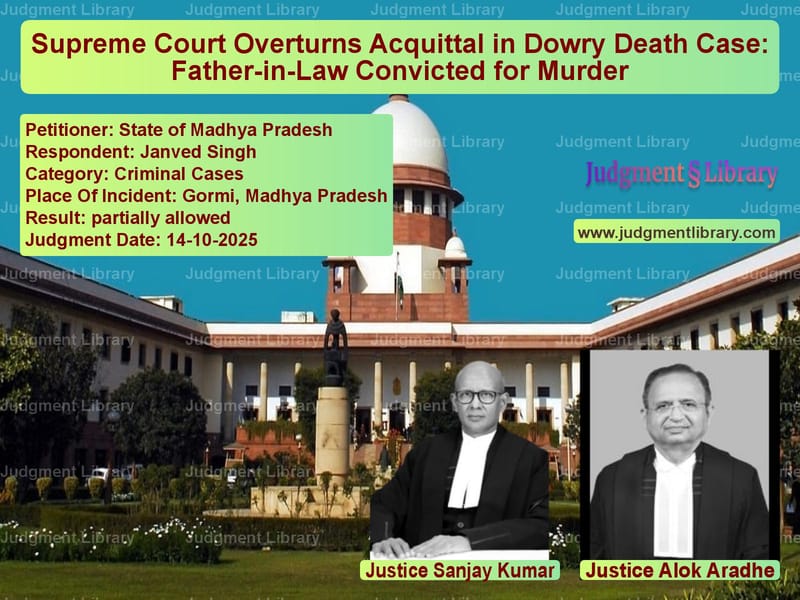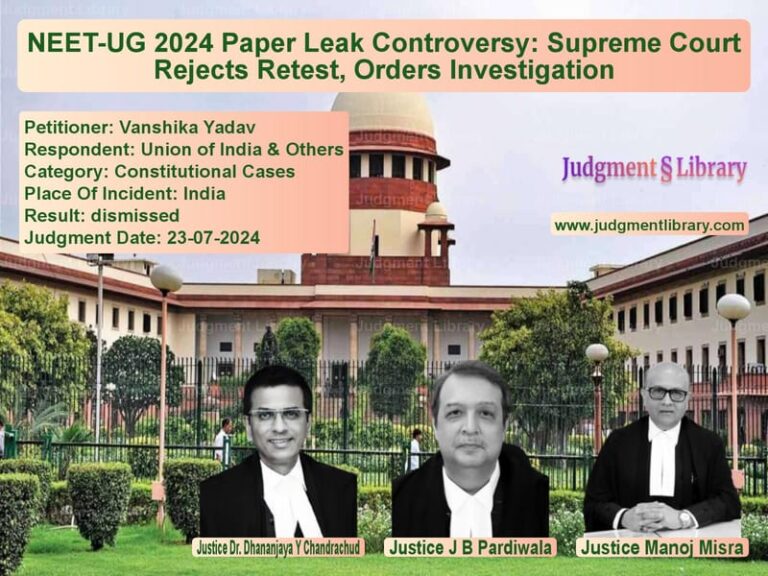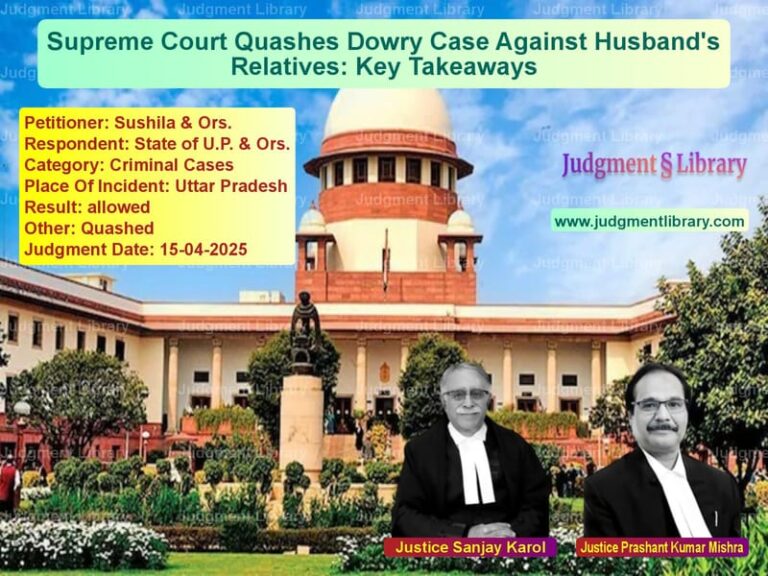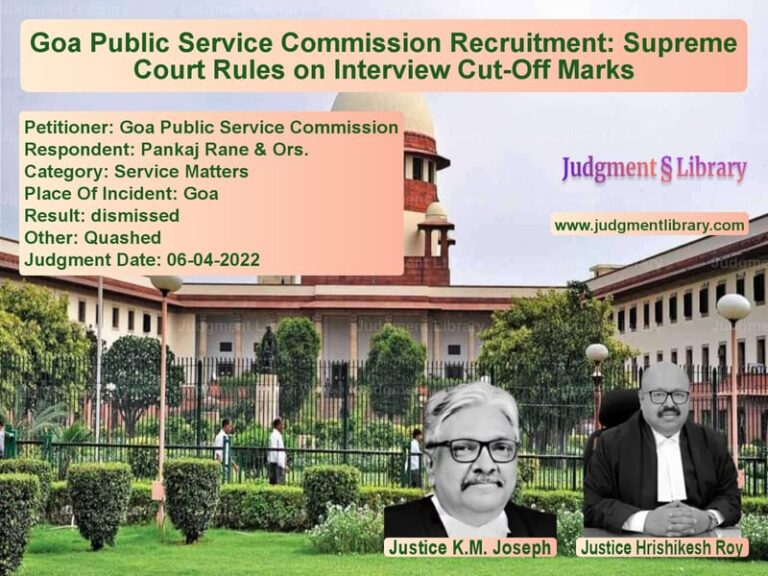Supreme Court Overturns Acquittal in Dowry Death Case: Father-in-Law Convicted for Murder
The law often steps into homes not to witness celebration, but to lift the veil from grief. The present appeal arises from such a home where warmth of a hearth turned into cold silence of death. These poignant words from Justice Alok Aradhe set the tone for a Supreme Court judgment that reversed the acquittal of a father-in-law in a harrowing dowry death case that had remained unresolved for nearly three decades. The case involved the mysterious death of Pushpa, a young married woman whose life ended under circumstances that her in-laws claimed was accidental electrocution, but which medical evidence revealed to be cold-blooded murder.
In a judgment delivered on October 14, 2025, by Justices Sanjay Kumar and Alok Aradhe, the Supreme Court restored the conviction of Janved Singh, the father-in-law of the deceased, setting aside the Madhya Pradesh High Court’s acquittal order. The Court found that the High Court had committed serious errors in reappreciating evidence and had failed to consider the complete chain of circumstances that pointed unequivocally to the guilt of the accused. This judgment represents a significant victory for justice in cases involving crimes against women within marital homes, where evidence is often circumstantial and the truth is concealed behind family walls.
The Tragic Case of Pushpa’s Death
The case dates back to December 31, 1997, when Janved Singh lodged a report at Police Station Gormi stating that his daughter-in-law Pushpa had died due to electrocution while ironing clothes. According to his version, he had returned from agricultural fields to find her dead. Based on this information, the police initially registered a Merg report under Section 174 of the CrPC.
However, during preliminary inquiry, the police noticed several discrepancies at the scene of occurrence and in the condition of the body. The post-mortem examination conducted by Dr. Devendra Khare revealed shocking facts – the cause of death was asphyxia due to strangulation, and the burn marks on the body were post-mortem. This completely contradicted the electrocution theory put forward by Janved Singh.
The investigation revealed that Pushpa’s marriage to Mahesh Singh (Janved’s son) was beset with discord and that she had been subjected to persistent harassment and cruelty for dowry. The police subsequently converted the case into a regular criminal case and filed a chargesheet against five accused persons: Janved Singh (father-in-law), Mahesh Singh (husband), Ramkali (mother-in-law), Sharda (sister-in-law), and Ahivaran Singh (brother-in-law).
The Trial Court’s Conviction and High Court’s Acquittal
The Sessions Court, after examining 20 prosecution witnesses and considering documentary evidence, delivered its judgment on January 11, 2000. The court held that the theory of electrocution was wholly fabricated and that Pushpa’s death was homicidal. The court convicted Mahesh Singh under Sections 304-B (dowry death) and 498-A (cruelty) of IPC, and Janved Singh under Sections 302 (murder), 498-A, and 201 (causing disappearance of evidence) of IPC. Janved Singh was sentenced to rigorous imprisonment for life, while Mahesh Singh received ten years of rigorous imprisonment. The other three accused were acquitted.
However, in an appeal filed by the convicted persons, the Madhya Pradesh High Court reversed the Trial Court’s judgment on April 6, 2010. The High Court acquitted both accused, holding that the prosecution had failed to establish that the death occurred within seven years of marriage, that the testimonies of the deceased’s parents were recorded after considerable delay, and that there was no evidence to show Janved Singh’s presence at the scene of occurrence.
The Supreme Court’s Critical Analysis
The State of Madhya Pradesh appealed to the Supreme Court against the High Court’s acquittal. Interestingly, the Supreme Court had earlier dismissed the appeal concerning Mahesh Singh (the husband) in 2011, limiting the present appeal only to Janved Singh’s acquittal.
The learned counsel for the State submitted that “High Court fundamentally erred in reappreciating the evidence and in discarding credible testimony of the witnesses.” He argued that “from the deposition of Sobran Singh (PW-2), Ilaychi Bai (PW-19) and Ramesh (PW-4) namely, parents and uncle of deceased Pushpa, it is evident that the facts of persistent harassment and cruelty inflicted upon Pushpa in connection with demand of dowry were well established.” He further emphasized that “autopsy report clearly proved that Pushpa was first strangulated and thereafter subjected to electric current in order to disguise the death as accidental electrocution.”
On the other hand, the counsel for the respondent contended that “there is no direct or circumstantial evidence connecting the respondent from the alleged offences.” He argued that “the statements of the prosecution witnesses (PW-2, PW-19 and PW-4) have been recorded belatedly and they are related to each other and therefore, cannot be relied upon.” He also submitted that “prosecution has failed to establish the exact year or date of marriage, an essential ingredient to attract an offence under Section 304-B of the IPC” and that “there is no material to show that Janved Singh was present at the time of death and no motive or any overt act has been attributed to him.”
The Supreme Court’s Legal Reasoning
The Supreme Court began its analysis by reiterating established legal principles. The Court noted that “a conviction for murder can solely rest on circumstantial evidence if the chain of circumstances is complete and consistent only with hypothesis of the guilt of the accused.”
The Court extensively discussed Section 106 of the Evidence Act, which deals with the burden of proving facts especially within the knowledge of the accused. The Court observed that this section “is designed to meet exceptional cases in which it would be impossible, or at any rate, disproportionately difficult for the prosecution to establish facts within the knowledge of the accused which he can prove without any difficulty or inconvenience.” The Court emphasized that “The word ‘especially’ used in Section 106 of the Evidence Act means the facts which are pre-eminently or exceptionally within the knowledge of the accused.”
The Court also relied on the principle that “when an accused offers a false explanation regarding the cause of death which takes place within the confines of his house, such falsity becomes an additional link in the chain of circumstances pointing to the guilt of the accused.”
The Complete Chain of Circumstances
The Supreme Court meticulously examined the evidence and identified a complete chain of circumstances pointing to Janved Singh’s guilt:
“(i) the unnatural death of the deceased which was not accidental but homicidal as established from the medical evidence, (ii) the death occurred inside the house occupied by accused No.1 which was under his control, (iii) the FIR lodged by accused No.1 himself establishes his presence in the house at the relevant time, (iv) the version of the accused No.1 that he had gone to the field is wholly unsubstantiated by any witness or independent corroboration, (v) the deliberate lodging of a false report of electrocution and an attempt to mislead the investigation, (vi) the strained relations between son of accused No.1 and his daughter-in-law and persistent demands for dowry.”
The Court powerfully concluded that “Each link fits seamlessly with the next, forming a continuous chain which points unerringly to the guilt of accused No.1 and excludes all reasonable hypothesis of innocence.”
The Court specifically noted that “The post-mortem report and evidence of Dr. Devendra Khare (PW-1) leaves no manner of doubt that death of the deceased was homicidal. The aforesaid witness has deposed that there were ligature marks around the neck consistent with strangulation. There was an injury on the body and the burn injuries were post-mortem.”
The Court found Janved Singh’s version completely unbelievable: “The version given by the accused No.1 namely, father-in-law to the Police that deceased died of electrocution while ironing the clothes stands falsified by medical evidence.” The Court also noted that “The deceased died in a room on the first floor. The incident had taken place 5.00 am in the morning. The accused No.1 was at home on the date of incident and had lodged false report that deceased died of electric shock.”
The Final Judgment and Its Significance
The Supreme Court held that “the prosecution has proved beyond reasonable doubt that the accused No. 1-Janved Singh caused the death of deceased by strangulation and attempted to mislead the investigation by fabricating a false story of electrocution.”
Accordingly, the Court set aside the High Court’s judgment and restored the Trial Court’s conviction and sentence of Janved Singh. The Court directed that “Janved Singh shall be taken into custody forthwith to serve out the remainder of the sentence.”
This judgment is particularly significant because it reinforces several important legal principles in criminal jurisprudence. First, it affirms that circumstantial evidence, when forming a complete chain, can be sufficient for conviction even in serious offenses like murder. Second, it underscores the application of Section 106 of the Evidence Act in cases where the facts are especially within the knowledge of the accused. Third, it establishes that when a death occurs within the confines of a house occupied by the accused, and the accused provides a false explanation, this falsity becomes an additional link in the chain of circumstances.
Most importantly, this judgment sends a strong message that courts will not allow technicalities to override substantive justice, especially in cases involving crimes against women within marital homes. By meticulously reconstructing the chain of circumstances and exposing the false defense, the Supreme Court has ensured that justice finally prevails for Pushpa, nearly three decades after her tragic death.
Petitioner Name: State of Madhya Pradesh.Respondent Name: Janved Singh.Judgment By: Justice Sanjay Kumar, Justice Alok Aradhe.Place Of Incident: Gormi, Madhya Pradesh.Judgment Date: 14-10-2025.Result: partially allowed.
Don’t miss out on the full details! Download the complete judgment in PDF format below and gain valuable insights instantly!
Download Judgment: state-of-madhya-prad-vs-janved-singh-supreme-court-of-india-judgment-dated-14-10-2025.pdf
Directly Download Judgment: Directly download this Judgment
See all petitions in Murder Cases
See all petitions in Dowry Cases
See all petitions in Domestic Violence
See all petitions in Attempt to Murder Cases
See all petitions in Custodial Deaths and Police Misconduct
See all petitions in Judgment by Sanjay Kumar
See all petitions in Judgment by Alok Aradhe
See all petitions in partially allowed
See all petitions in supreme court of India judgments October 2025
See all petitions in 2025 judgments
See all posts in Criminal Cases Category
See all allowed petitions in Criminal Cases Category
See all Dismissed petitions in Criminal Cases Category
See all partially allowed petitions in Criminal Cases Category







